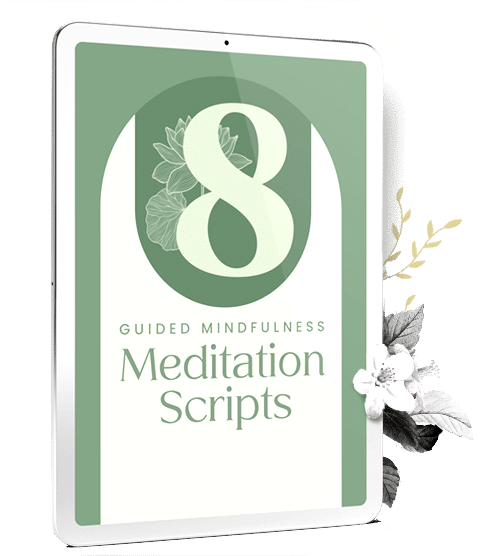“Mr. Duffy lived a short distance from his body…” This is how James Joyce describes one of the main characters in his book Dubliners.
It is Joyce’s way to describe going through life disconnected from our bodies. The pace of modern living can keep us moving so quickly, it can be hard to slow down and actually inhabit our bodies. We get a bit stuck in our heads and out of touch with our emotions.
But, being in tune with your body, and the unique information it has for you, is an essential piece of being present, self-aware and able to connect with others.
Body scan meditations show you how to reconnect with the richness and intelligence of your body.
What is Body Scan Meditation?
Body scan meditation is a mindfulness technique that involves systematically focusing your attention on different parts of your body in order to release physical tension and increase awareness of sensations in the present moment.
Body scan meditations are some of the oldest forms of meditation. Sensing and being present in the body is seen as a fundamental need for human health and well-being.
Meditation body scans come in different forms, but they share the same basic flow. You are guided through paying close attention to your body in a systematic way. You take the time to connect with the sensations in your head, your neck, your torso, and so on. The pace is slow, encouraging you to stay in one place long enough to feel what is present.
The goal is simply to connect mind and body, and discover what is there. It can feel like coming home.
Body scans are a powerful tool to support you through uncomfortable experiences. Sometimes there are good reasons to disconnect from your body, like physical pain or the emotional pain of a loss. Body scans teach you how to be with these experiences with clear eyes and open hearts.
Meditation teacher, Vidyamala Burch, has lived with intense physical pain for over three decades. She created an award-winning, breath-based body scan program to help others manage–and even thrive– living with chronic pain.

How to Do Body Scan Meditation?
You can follow these steps for any body scan meditation. Set aside at least 15 minutes to do your practice.
Get Comfortable
Lying down is the best position for this exercise, but if that is difficult for you, sitting up is fine. Make sure you’re warm and comfortable, and won’t be disturbed.
Let Your Mind and Body Settle
Take a few minutes to settle in. Are you aware of any areas of obvious tension or holding in your body? Invite your body to relax and rest into gravity.
Start Your Scan
Let your attention rest at the top of your head. Does it feel warm, tingly or tight? Stay in this area until you feel connected to these sensations for at least 30 seconds. Then let your attention move to your face. Notice the sensations there, until you feel them clearly. Continue down through your body, letting your attention move and settle from place to place. If you find you can’t connect with a particular area after a few moments, it’s ok. Move on and come back later, if you like.
Go Slowly
Be aware of wanting to move on before you have connected with the sensations. Your mind may become impatient or restless. See if you can put that aside for the moment and come back to feeling your body. The more attention you pay to sensations, the less attention you will have for thoughts.
Notice and Accept
You may experience some kind of discomfort during the practice, like tension in your back that you weren’t aware of before. Or, you might realize you’re quite angry at your partner about a recent argument. The practice is to notice what has come up and to let it be without judgement. Try to focus your attention on the body sensations associated with your discomfort, rather than any stories about it. And, always, always be kind and compassionate with yourself and the challenges this may present for you.
Expect Thoughts
Do not be surprised and do not criticize yourself when your mind wanders away. If it was easy to stay connected to your body, you would do it more often! This is what the body scan meditation is for: to help you prioritize your body’s experience, over your mind, just for a few minutes. As you practice this over time, you’ll be more able to do this in the moment with stressful thoughts and worries.
Befriend Your Breath
If you lose your way and become unsure of what to do, come back to feeling the sensations of your breath in your chest or belly. The breath is the best pathway back to connecting with physical sensations.
Finish Mindfully
At the end of your practice, take another moment to pay attention to how your body and mind feel.

Benefits of Body Scan Meditation
These are some of the benefits people enjoy from body scans. These benefits become stronger and more automatic, the more you practice.
Reducing Stress
Body scan meditations have been shown to activate the parasympathetic nervous system. They signal your brain and body to relax and heal.
Increasing Self-compassion
Sometimes we tune out of our bodies because there is a difficult emotion we would prefer not to feel. A body scan is a gentle, supportive way to connect with how emotions are showing up in your body. When you become more aware of your own sadness or loneliness, the result is often self-compassion. You become a friend and a refuge for yourself.
Giving Your Mind a Rest
In some ways, body scan meditations are the most accessible for beginners. You can give your mind a rest and focus on the in-the-moment physical sensations in your body. It’s much harder for your mind to be caught in thoughts and worries when your attention is anchored in your body.
Noticing All Kinds of Information
Information about your internal and external world comes to you through your body, mind and emotions. We often pay the most attention to what our minds and emotions are telling us, and leave our body out of the mix. Body scans show us how to tune into the present-moment information from your body.
Handling Difficult Emotions
All of these benefits give you tools to be with the everyday challenges of your emotions. You learn how to stay with discomfort, be kind and non-judgmental about your emotions, and be a good friend to yourself.

Tips for an Effective Experience
Here are some tips to make your body scanning meditations as effective as possible.
Stick to Your Chosen Practice Time
Choose a length of time to practice and stick to it. You will learn much, much more from the practice if you ride out feelings of impatience or boredom.
Create a Routine
Stress is a daily reality for many people, so having a daily de-stressing routine is a wise choice. Small, everyday stresses are easier to notice and manage than stress that has accumulated over weeks or even months. Give your body and mind the gift of regular release from stress.
Learn to Enjoy Slowing Down
If racing through your day feels commonplace to you, slowing down may be extremely difficult. But, settling in to a slow, step-by-step body scan is like an internal spa day. Learn to enjoy a few moments of getting out of your mind and into your body, with nothing to do but breathe and feel.
Best Body Scan Meditation Worksheets & Scripts
We’ve gathered some of our favorite body scan scripts, guided meditation, and worksheets for you.
Check out our audio player, to engage in a short and efficient meditation session, allowing you to take a break from the hustle and bustle of daily life and find inner peace.
FAQs on Body Scan Meditation
What Is Body Scan Meditation Used For?
Body scan meditations are used for stress relief, reducing anxiety, improving sleep, pain relief, and more.
How Long Does A Body Scan Meditation Take?
Body scans can be done in as little as five minutes. However, the essence of a body scan is honoring the time you need to connect with your body. For one person, this may take 10 minutes, for another 45 minutes or even longer.
How Do You Feel After Body Scan Meditation?
After meditation body scans, people usually describe feeling more relaxed in body and mind. Their minds are a little clear and calm.
How Does Body Scan Help With Anxiety?
Body scans help with anxiety in a few ways. They trigger relaxation in your nervous system. They help you let go of worrying thoughts that are often part of anxiety. And, they guide you to being more present with emotions, rather than avoiding or suppressing them.
Medical Disclaimer
The information contained in this article is not a substitute for any professional advice or treatment, including the advice and treatment of a licensed health care or mental health professional.














